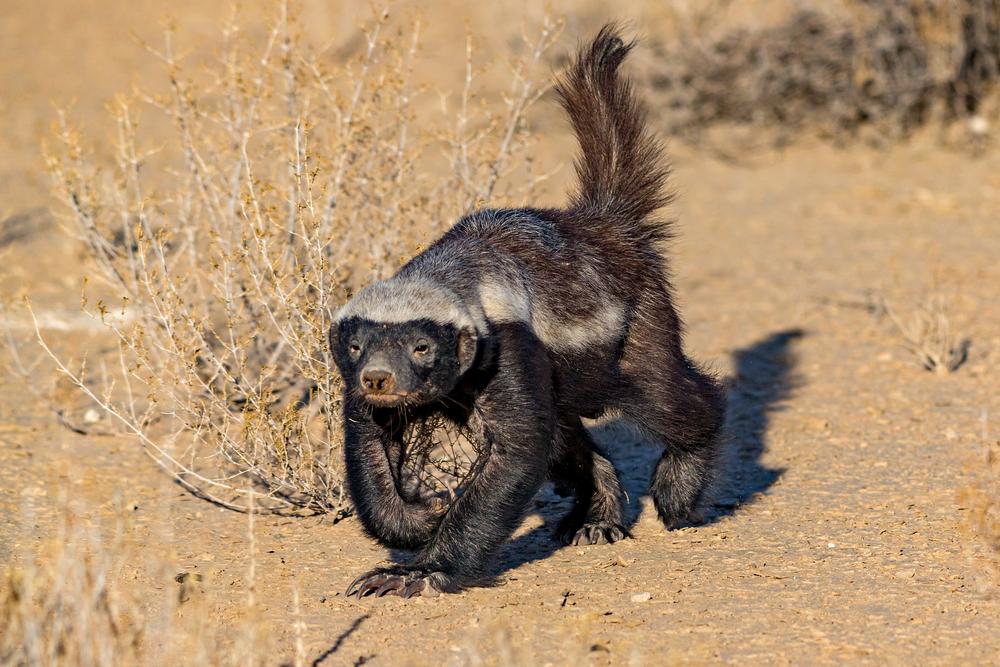

Fearless, vicious, and aggressive! Those three words sum up the honey badger to a T! A solitary omnivore that is prominently nocturnal, the honey badger is a 35-pound specialty animal with a bad attitude, and a perfect trophy when hunting in South Africa. Although the honey badger’s numbers are decreasing, it has a conservation status of “least concern” with the IUCN.
Honey badgers (Mellivora capensis) are also known as ratels. They inhabit mainly dry areas but also live in forests and grasslands. Honey badgers are native to many regions in Africa and Asia, and western India. In South Africa, they occur throughout the country, except in the north-west coastal areas. Honey badger hunting in South Africa usually happens at night, using bait.
They are known as fearless, opportunistic hunters, and they are omnivores whose diet varies according to which type of food is in abundance at the time. Honey badgers are known to feast on insects, amphibians, reptiles, birds, mammals, roots, bulbs, berries, and fruits. They also have a particular fondness for honey and honeybee larvae.
Although mainly seen as a nocturnal hunter, the honey badger will hunt in the day, together with a bird called a honeyguide. These honeyguides are known as indicator or honey birds and guide the honey badger to bee hives. The honey badger then breaks open the hive, taking their fill and leaving the nest for the honeyguide.
It is difficult to find a more irritable or confrontational animal than a honey badger. Their predators include lions, leopards, hyenas, and man. Unfortunately for these predators, the honey badger does not back down but will retaliate and attack even lions and buffalos when it is in danger! Now that’s an animal with confidence!
Speaking of confidence, the honey badger is a confident and skilled hunter. This little creature may be short in stature, but makes up for it with sheer guts, aggression, and heart. It has no reservations about chasing young lions from their kills and has attacked waterbuck, wildebeest, and even buffalo! It is no wonder the Guinness Book of Records has named them the “World’s Most Fearless Creature” and a great trophy to add to your game hunting displays.
Honey badgers only meet up to mate, which happens every 14-24 months. Females (sows) have a gestation period of 181 days and give birth to one to two cubs. The male (boar) plays no role in rearing the young, who stay with the female until weaned at around 14 months.
Name:
Mellivora Capensis
Weight:
22-35 pounds
Shoulder Height:
9-11 inches
Range:
Africa, Asia, and India
Gestation:
181 days
Mating Season:
Every 14-24 months
Life span:
Unknown but up to 24 years in captivity
Experience a Thrilling African Hunting Safari by Pursuing the Honey Badger.
Hunting safaris should look for a medium-sized creature with a stocky, flattened body, and short, strong legs. They have long claws on their front feet used to hunt and as a defense against predators. Honey badgers have coarse, thick hair that is mainly black, except for a wide grayish-white stripe that runs the length of its body from top to tail. African honey badger boars weigh 20-35 pounds, while the sows weigh 11-22 pounds. Boars measure up to 2.4 feet in length, with their tail adding an additional 0.5-0.8 feet. A sow’s head and body length measures 2.1 feet, with its tail measuring an additional 0.5-0.6 feet.
When hunting honey badgers at night in South Africa, a special prearranged permit, as well as a Threatened or Protected Species (TOPS) permit, is needed. These need to be obtained prior to the game hunting safari. Hunting safaris for the honey badger happen in the Northern Cape, North West, Mpumalanga Lowveld, and the Limpopo province of South Africa. The most successful type of hunt for honey badgers takes place at night, using bait and waiting for the honey badger to appear. Hunting honey badgers with hounds is not a very successful exercise, as the toughness and looseness of the skin allows the honey badger to turn on their attacker, and because the skin is so tough, there is not much damage.
Honey badgers are notoriously aggressive and will fight tooth and nail when cornered and trust me, you do not want to be close to an angry honey badger! The reward of hunting this specialty animal is the chance to add new memories of your time hunting in South Africa.
Hunting honey badger can be achieved with a well-placed bullet from a small caliber rifle such as a .243. Shot placement to the heart is critical. These animals are tough and can disappear into the night. Use a larger caliber rifle with solid tips, or the trophy is ruined.
Search from our range of Hunts across various popular destinations in Africa.
Find A Hunt